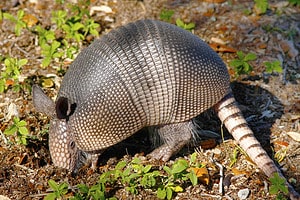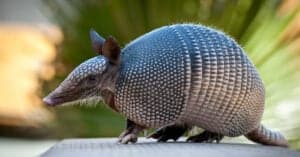Armadillos are distinctive and unique animals—they are the only mammal on earth with an armored shell! In fact, their name means “little armored one” in Spanish. These cute little creatures originally came from South America during the Cenozoic Era, but today they live in South America, Central America, and North America. The most iconic feature of an armadillo is the heavily armored shell on its back. However, there is much more to this bulletproof animal than meets the eye. For example, did you know that some armadillos can jump several feet into the air? Or that the smallest armadillo is only 6 inches long? Let’s take a closer look at 10 incredible armadillo facts!
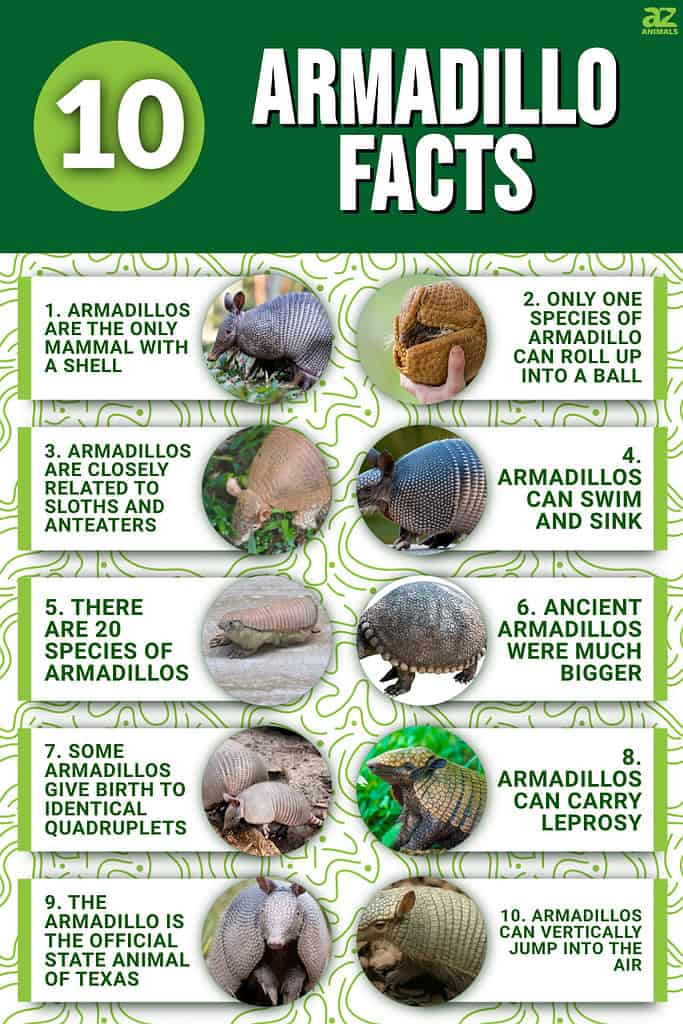
1. Armadillos Are the Only Mammal with a Shell
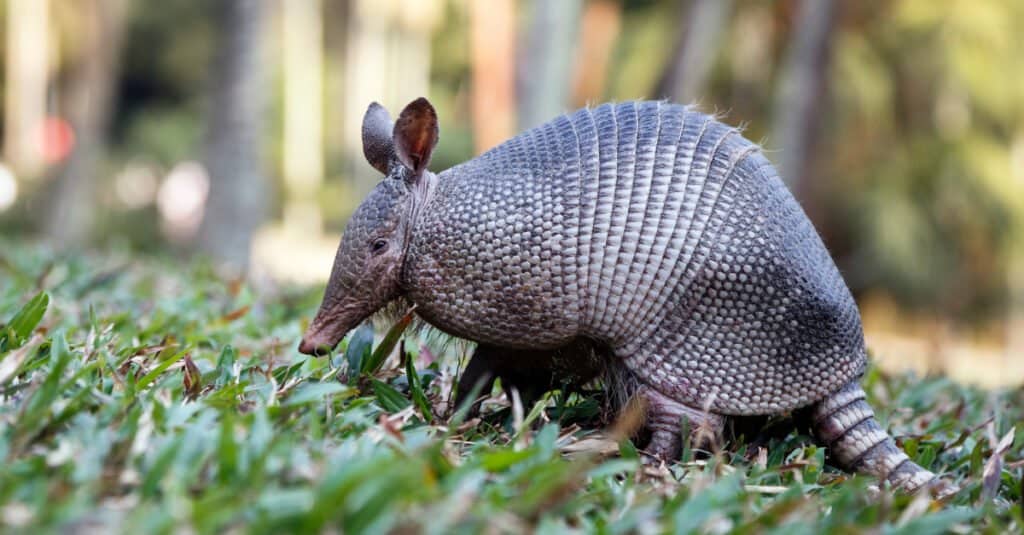
Armadillos are covered in bony plates. They are the only living mammal to wear such a shell.
©Klaus Balzano/Shutterstock.com
The first incredible armadillo fact is of course their iconic armor. The shell on an armadillo’s back is made of thick bone and is connected to its vertebrae. The six-banded armadillo, however, has a slightly different shell. Although it is also made of thick bone, there is an additional layer of keratin on top, making it extra strong. The plates of armadillo shells overlap one another to create even more protection for this animal. With strong bone, sometimes keratin, and numerous layered plates, an armadillo shell is tremendously strong and provides excellent protection for armadillos of all sizes.
In fact, an armadillo shell is so strong that it has inadvertently caused injuries in humans who have attempted to attack these armored animals! There have been numerous reports of humans shooting armadillos, only to have the bullet ricochet off the animals’ protective shell and injure the shooter instead!
While heavily armored shells protect their backs, long, sensitive hairs called “curb feelers” cover armadillo bellies. These hairs act like whiskers on a cat, helping armadillos to sense and feel their surroundings, even in the dark.
2. Only One Species of Armadillo Can Roll Up into a Ball
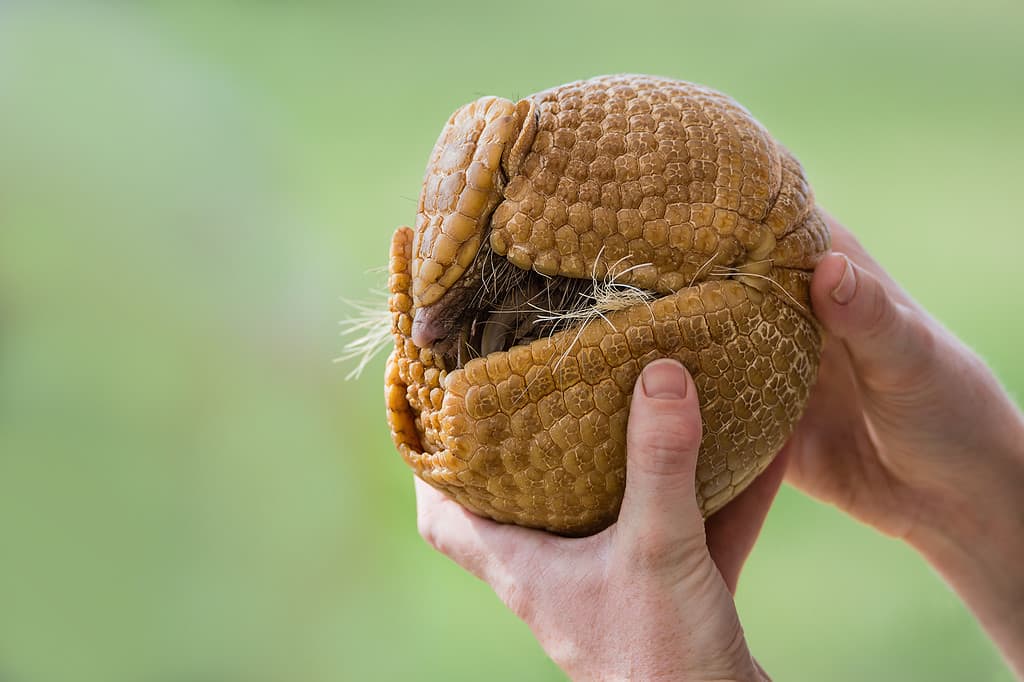
There is only
onearmadillo species that can completely roll itself into a ball: the three-banded armadillo.
©leekris/ via Getty Images
Cartoon armadillos are always rolling themselves up nicely into a neat little ball. In real life, however, most armadillos do not have that kind of flexibility. In fact, there is only one armadillo species that can completely roll itself into a ball: the three-banded armadillo. When it feels threatened, the three-banded armadillo will jump a few inches off the ground and immediately tuck its head, feet, and tail into a tight, compact ball. The armadillo’s armored head and tail fit together like perfect puzzle pieces, keeping its entire body shielded safely within its protective shell.
3. Armadillos Are Closely Related to Sloths and Anteaters
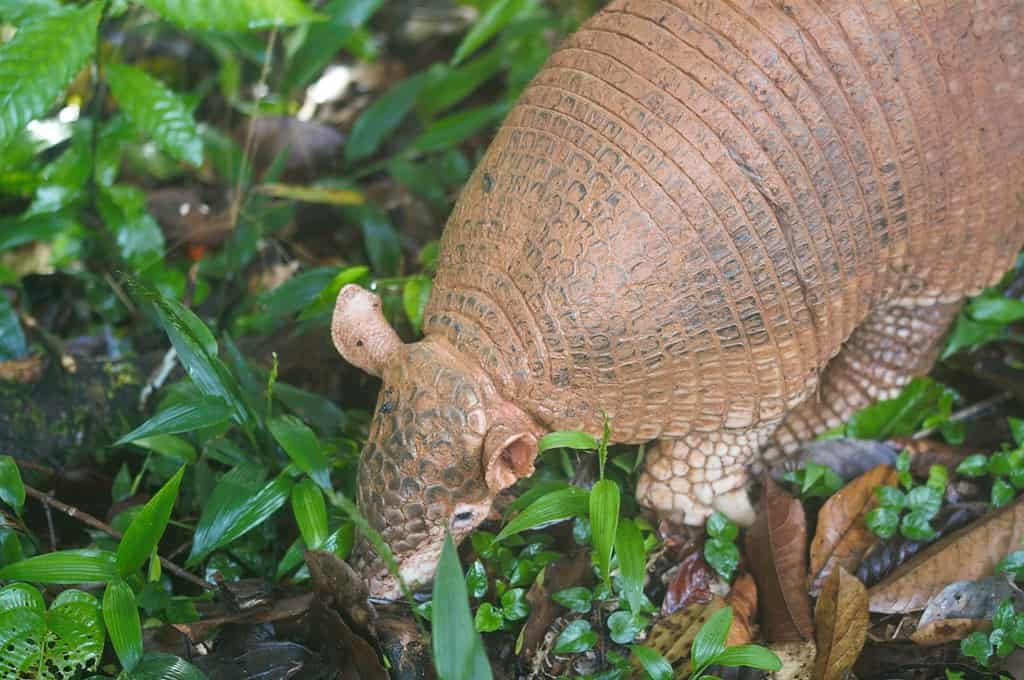
This giant armadillo is displayed at the Harvard Museum of Natural History in Boston, MA.
©Guillaume Delaitre, CC BY 4.0, via Wikimedia Commons – License
You might think that an armadillo and a pangolin look alike, but it turns out these two animals are not at all related. Here’s another amazingly incredible armadillo fact: armadillos are actually closely related to sloths and anteaters! These three types of animals are all part of the scientific superorder “Xenarthrans”, which is Greek for “strange joints.” They may not look alike, but they have many similar characteristics. For example, although they typically move much more quickly than their sloth cousins, armadillos are nocturnal and sleep for 16 hours every single day!
Like anteaters, armadillos have long sticky tongues that they use to get termites and ants from underground tunnels. They prefer invertebrates like ants, termites, beetles, worms, grubs, and insects, but will also eat plants and fruit occasionally. Armadillos have small eyes and relatively poor eyesight, so they rely on their excellent sense of smell when hunting for food. Some armadillos can sniff out bugs 6 inches under the dirt! They have very large, thick claws on their front feet and are expert diggers.
Unfortunately, because of these excellent digging skills, armadillos are commonly seen as pests, particularly when they dig in gardens. However, armadillos are excellent pest controllers and will keep any pesky bugs out of your yard. In addition, there are many humane methods to deter armadillos from digging up your flower garden. For example, you can put soil and earthworms in an empty flowerpot in your yard or garden. Resident armadillos will love it so much, they will leave the rest of your garden alone!
4. Armadillos Can Swim and Sink

Nine-banded armadillos can float by inflating their intestines or sink to run across riverbed floors.
©Heiko Kiera/Shutterstock.com
Armadillos have very heavy shells and instantly sink in water. In fact, an armadillo can hold its breath for up to six whole minutes while it walks right across the bottoms of streams, rivers, lakes, or ponds! However, armadillos can also float and swim in water. Before entering the water, an armadillo will take several deep breaths and swallow lots of air to inflate its stomach. This provides buoyancy and helps to keep armadillos afloat even with their hard bony shells.
5. There Are 20 Species of Armadillos
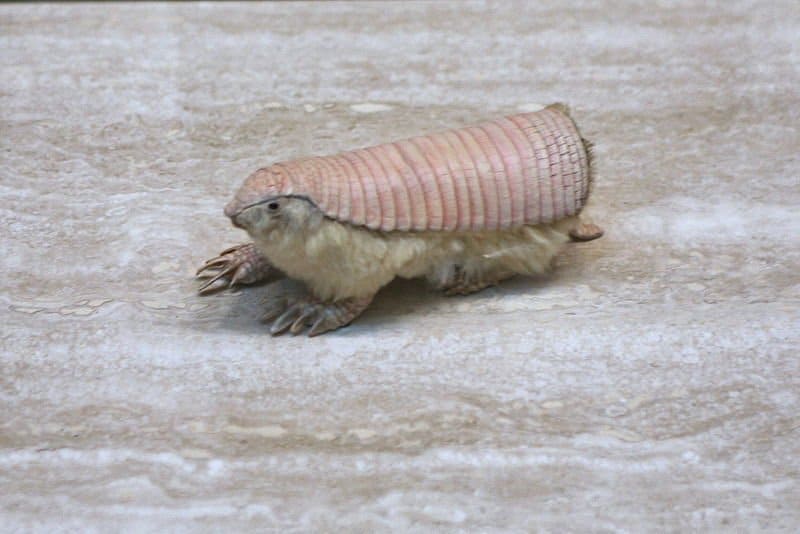
Pink fairy armadillos have a shell but it’s softer, thinner, and flexible and covers about half their body.
©Cliff / CC BY 2.0 – License
There are at least 20 different species of armadillos living throughout the western hemisphere in South, Central, and North America. Although each species looks similar with a bony armored shell, they come in many different shapes and sizes. For example, the smallest armadillo species, the pink fairy armadillo, is only 5-6 inches long, and weighs less than a pound! Pink fairy armadillos are endemic to central Argentina. However, these tiny armadillos are extremely fragile and temperamental, so they are rarely seen.
The largest armadillo is the giant armadillo, which can grow up to five feet long and weigh nearly 100 pounds! These armadillos are also rare and are listed as Vulnerable to Extinction by the IUCN Red List. Unfortunately, nearly all populations of armadillo species are declining due to habitat loss, human threats, and predation from domesticated pets.
6. Ancient Armadillos Were Much Bigger
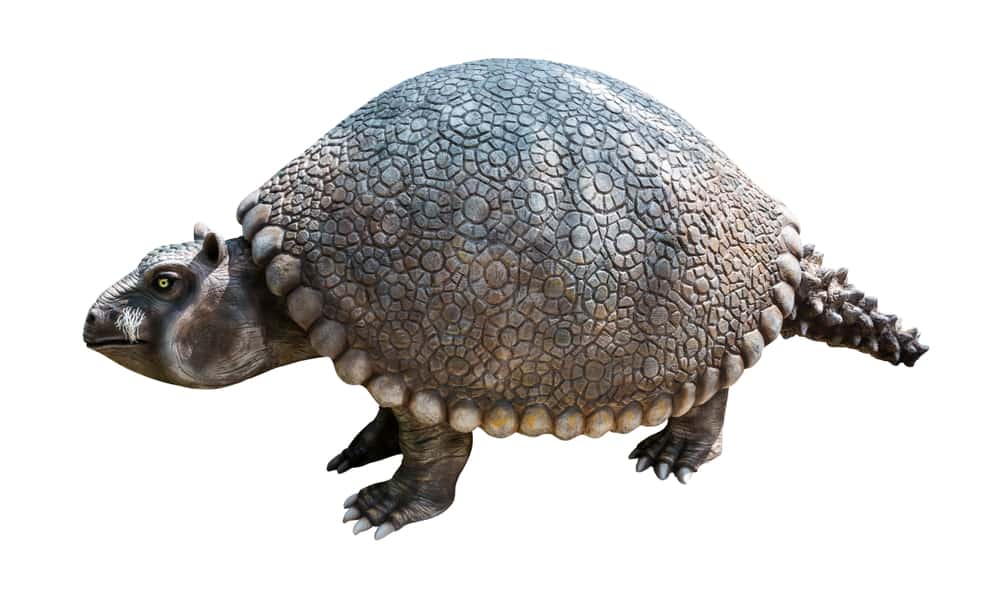
The Glyptodon was an ancient armadillo about the size of a Volkswagen Beetle car.
©YuRi Photolife/Shutterstock.com
While the largest armadillo on earth today can grow up to five feet in length, ancient armadillos were much, much bigger. The Glyptodon, for example, weighed one to two tons and was over 10 feet long! This colossal armadillo was an herbivore that ate plants instead of meat or insects. The glyptodon lived about one million years ago during the Pleistocene epoch, up until the last Ice Age. Early humans in South America often killed glyptodons not only for their meat but also used their large shells for shelter.
7. Some Armadillos Give Birth to Identical Quadruplets

Armadillos give birth to live young. They typically have large litters of up to 15 baby armadillos.
©Rose Waddell/Shutterstock.com
The nine-banded armadillo is unique because females give birth to identical quadruplets! Not only do all four armadillo babies look the same, but they are also the same gender and share identical DNA since they each originate from the exact same egg. Seven-banded armadillos also give birth to identical offspring, but a female armadillo may have between 4-8 babies at a time.
Baby armadillos are born with soft, leathery skin. Within a few weeks, however, it begins to harden. Armadillo mothers care for their young until the babies are 6-12 months old. After that the armadillo family will split up and go off on their own, typically living solitary lives until breeding season.
8. Armadillos Can Carry Leprosy
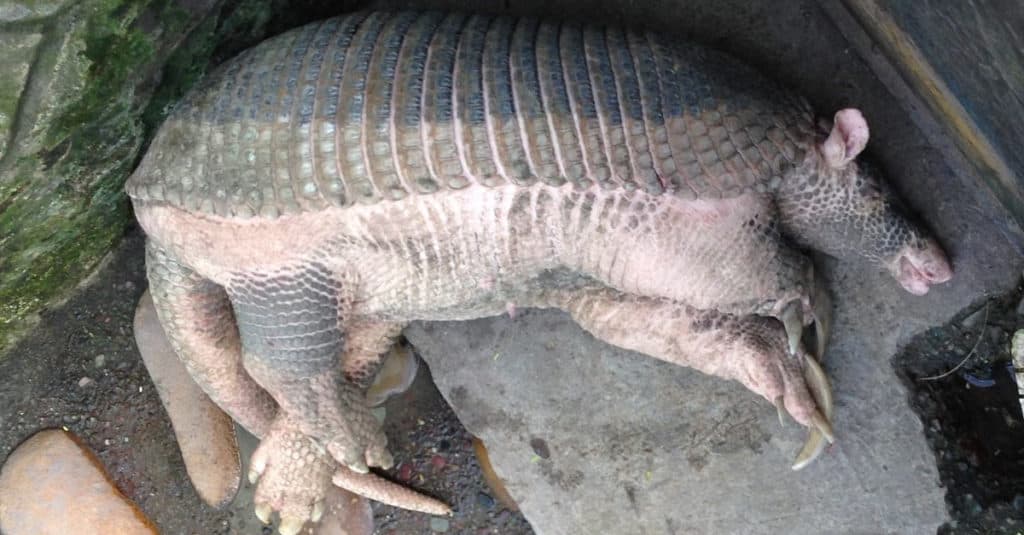
Leprosy requires a cool surface to grow. Since armadillos have low body temps, they are susceptible.
©pipeafcr / CC BY-SA 3.0, Wikimedia Commons – License
Around 500 years ago, European settlers and Spanish conquistadors accidentally brought several never-before-seen diseases to South America, including leprosy. The bacterium that causes leprosy requires a cooler skin surface to grow. Since armadillos have lower body temperatures and slow metabolisms, they are more susceptible to this disease. Many contracted it from the new human settlers. Unfortunately, leprosy can now travel from armadillos to humans as well.
However, the chances of getting leprosy from an armadillo are extremely small. In some areas of the southern United States, it is common to eat armadillo meat, which is the most likely way to get leprosy from an armadillo. Since armadillo meat can give you leprosy, and these animals are already suffering from declining populations, it’s better to keep them off the menu. This will keep both you and the armadillos safe from unnecessary harm.
9. The Armadillo is the Official State Animal of Texas
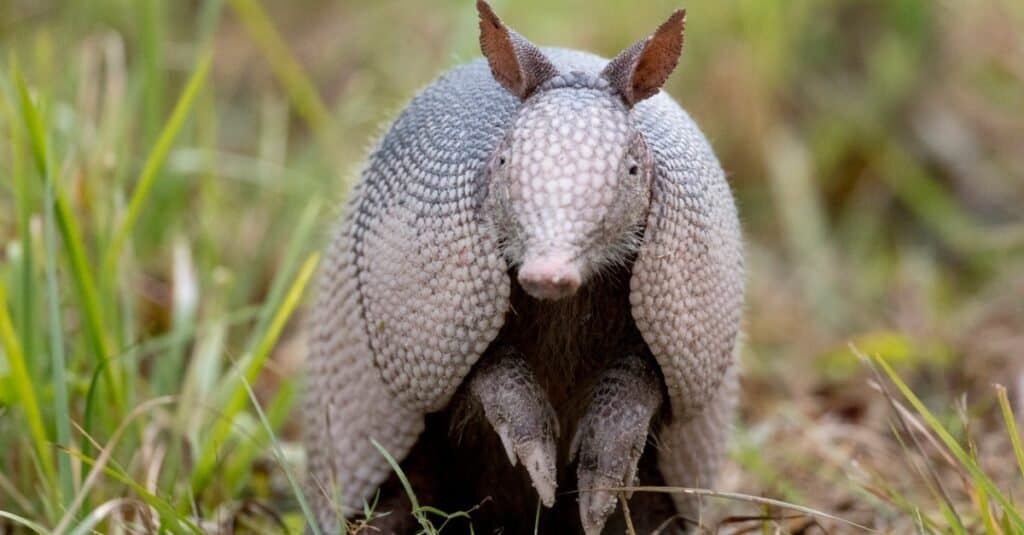
The armadillo’s armored appearance makes it look reptilian, but this almost hairless animal is a mammal.
©iStock.com/6381380
Armadillos mainly live in South and Central America. The nine-banded armadillo is the only armadillo species that has traveled north into the United States. Nine-banded armadillos commonly live in many southern states like Texas, Georgia, and Missouri. They grow between 25-48 inches long and weigh 8-18 pounds. In Texas, nine-banded armadillos have acquired the unfortunate nickname of “hillbilly speed bumps”. These animals are often hit by cars when crossing roads. When they are startled, they jump straight up, causing them to hit the undercarriage of passing cars.
Another unlucky nickname for the nine-banded armadillo is the “Hoover Hog”. During the Great Depression, many people blamed President Hoover for the lack of meat and learned to cook armadillo meat instead. However, as we saw earlier, it is not safe to eat armadillos, so it is best to steer clear of this practice.
10. Armadillos Can Vertically Jump into the Air
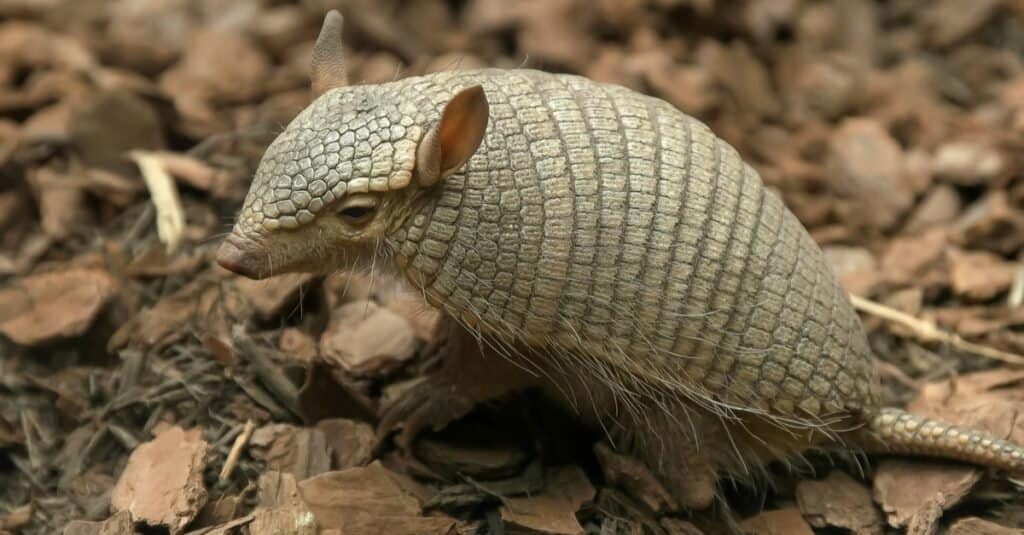
The screaming hairy armadillo is one of the smallest species. It squeals when handled or threatened.
©crbellette/Shutterstock.com
While the three-banded armadillo can roll its body into a perfectly protected armored ball, other armadillo species use additional defensive tactics. Generally, armadillos run away from predators or threats and hide in underground burrows. However, some armadillo species will also jump vertically into the air when startled or threatened. In fact, the nine-banded armadillo can leap 3-4 feet straight up into the air! Scientists believe that this tactic startles and confuses predators, giving the armadillo time to run away from the threat.
The photo featured at the top of this post is © Heiko Kiera/Shutterstock.com
Thank you for reading! Have some feedback for us? Contact the AZ Animals editorial team.



